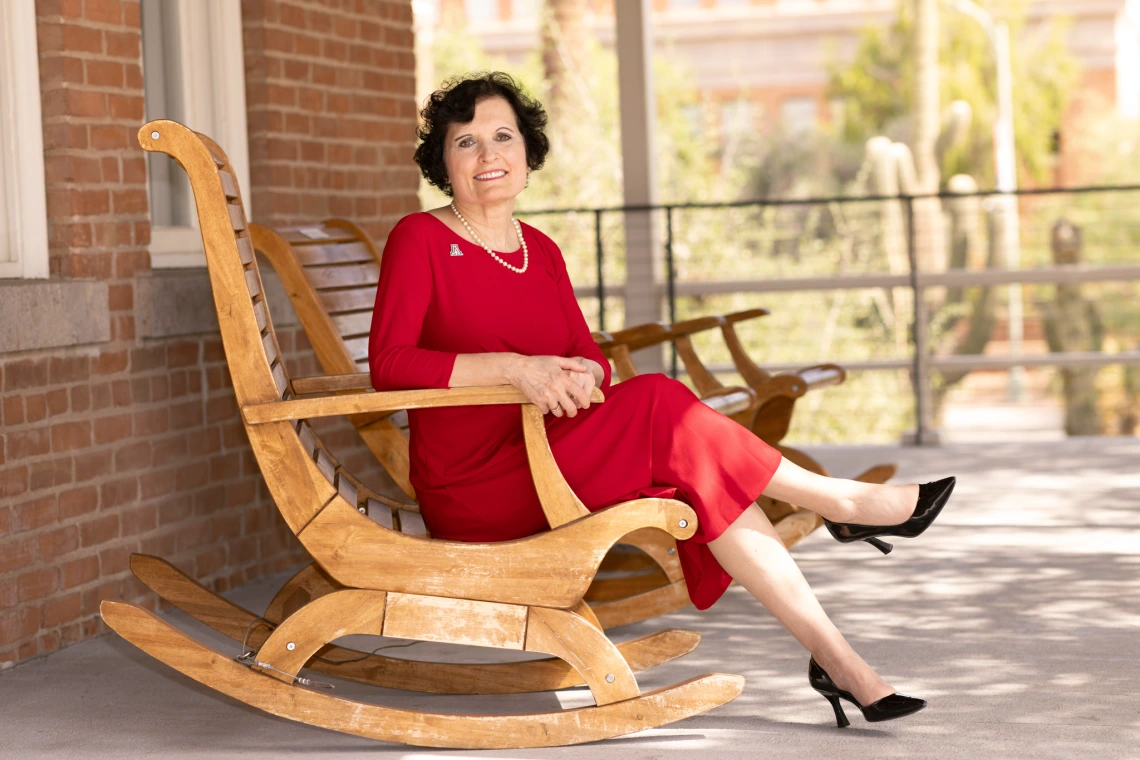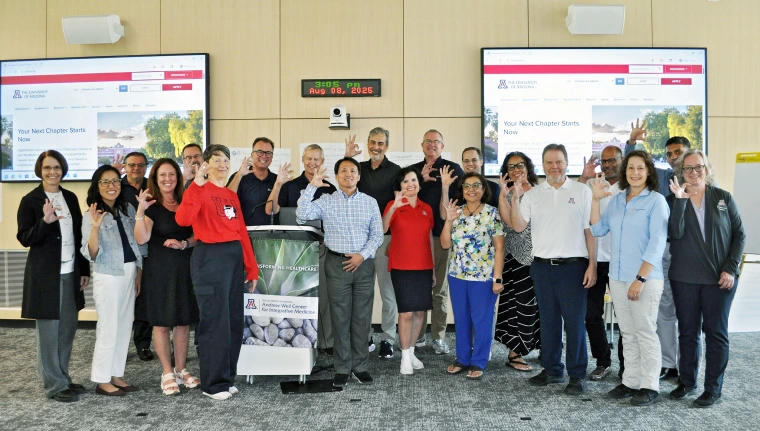Learning to Lead
New provost Patricia Prelock grew up one of six siblings and a first-gen college student before becoming provost at the University of Vermont. Now she’s bringing her clarity and resilience to Tucson.

Patricia Prelock
Chris Richards
Patricia Prelock arrived in Tucson from Vermont’s Green Mountains, stepping into Tucson’s June heat at the start of the monsoons. When we meet in her Old Main office, she’s walked across campus in sneakers. She swaps her kicks for pink patent leather heels, already embracing the bright Southwestern palette.
As provost of the University of Arizona, she’s charged with implementing strategic imperatives — “President Garimella calls it ‘delivering on our promise,’” she says. “The things we must do to raise up U of A.” Those imperatives are straightforward: success for all students, research that shapes the future and engagement with our communities to create opportunity, all anchored by the university’s land-grant mission. Her approach is practical. “A strategic vision is only as good as the implementation plan,” Prelock says. “You must have a way to say, ‘We actually did those three things.’ So that’s my job.”
An accomplished scientist and scholar in clinical speech-language pathology, Prelock became UVM’s provost in 2019. She served under Suresh Garimella, then UVM’s president, and later took over as interim president after Garimella left for Arizona. Earlier, she had spent a decade as the dean of UVM’s College of Nursing and Health Sciences and seven years as chair of the Department of Communication Sciences. Under her leadership, UVM achieved Research 1 status. “It was a pretty scrappy institution,” she says. “With limited funding from the state, we learned to how to do more with less.” The U of A faces similar funding challenges, and has for years, which perhaps makes her arrival feel all the more fitting.
Prelock grew up in Ohio and was the first in her family to attend college. She earned bachelor’s and master’s degrees from Kent State University in northeastern Ohio, followed by a doctorate in speech-language pathology from the University of Pittsburgh. She’d actually considered coming to the U of A for her undergraduate studies, but life intervened — her mother had just welcomed another baby, and Prelock stayed closer to home to help take care of her youngest brother. She personally relates to U of A’s significant population of first- generation students. “I was the second-oldest of six children and a first-generation student [myself]. So, I really appreciate the context here.”

Patricia Prelock at the Council of Deans retreat in August 2025.
Nina Bates
She’s gotten a sense of the U of A in her first several months, hosting campus community conversations, immersing herself in campus culture and acclimating herself generally to what makes the U of A tick: the Bear Down spirit, passed down through generations. “You talk about resilience in the desert, and as you learn this culture, that’s what people say: to live here, you have to be resilient. And ‘Bear Down’ is really about that, too … about people being part of something greater than themselves.”
She sees the paradoxes that desert dwellers understand all too well. “When I saw we were No. 1 in hydrology, I thought, in the desert? And then I realized — of course. You have to be, with no water.”
“When I looked at this job and saw so many programs ranked in the top 10 or top 20, I thought, ‘This is an amazing institution,’” she says. “Yes, the U of A has faced financial challenges and leadership changes, and sometimes a university can lose its way — but the core of the U of A has always been here.” That enduring spirit, she adds, is worth celebrating: “We are Arizona’s flagship, land- grant university. We are an AAU, R1 institution. We should be proud of that.”
Resilience runs through her own story. Her paternal grandparents came through Ellis Island from Italy and what was then Austria-Hungary (what is now Czechia); her grandmother, the eldest of nine, spoke no English and left school in sixth grade, when her own mother died, to raise her siblings. “To me, that’s resilience,” Prelock says. “They lived through two world wars, a pandemic and the Great Depression. They thrived. They figured out how to keep food on the table.”
Her parents were both smart but lacked the opportunity to attend college; they were determined that their children would. Her mother took her to the library every week. “You had to get two or three books, read them and then go back. My oldest brother read 500 books his senior year, because that’s what we did.” Four of Prelock’s siblings died young. “I saw my mom manage that,” she says. “That’s resilience.”
Early in Prelock’s career, frequent moves with her late first husband taught her to adapt. “There was no job? I’d write a grant,” she recalls. That resourcefulness shaped an unconventional academic path — one she admits was challenging but ultimately fostered what she describes as “the ability to create my own space.” Looking back, she shares, “I wasn’t looking for leadership. Leadership found me.”
A brother with Down syndrome led her to a career in speech-language pathology. “My expertise is in the nature and treatment of autism,” she says. She honed the softer skills of leadership working with autistic children and adults with a range of disabilities, cultivating what she calls her “superpower”: listening with empathy.
“They taught me how to listen in different ways, to think differently and to understand that somebody might have a different perspective than my own,” she says. Her students also introduced her to the concept of double empathy: the idea that just as neurodiverse individuals work to navigate a neurotypical world, neurotypical people must also learn to navigate the world of people with neurological differences.
“My neurodiverse students would say, ‘You’re helping us adjust to the neurotypical world. But why aren’t you adjusting to manage [in] my neurodiverse world?’” She recalls, “Point well taken. We have to give a little on both sides.”
She also happens to be an amateur magician, a hobby that provides unexpected relevance to her work. “There is a neuroscience element to magic, with sleight of hand and perspective- taking,” she says. “For the autistic children I work with, I like to share simple tricks and give them the banter that goes along with it — it becomes a way for them to engage socially.” On a simpler level, “I love the delight that magic brings to those who appreciate the pure wonder of ‘what just happened?’”
As a new hire in a period of institutional transition, Prelock has the unusual opportunity to step back and ask the big questions: What are our goals? How successfully are we pursuing them? What can we approach differently?
“We have to remember why we have higher education,” she says. “It’s about learning to think critically, solve problems, examine issues, ask the right questions and find answers.”
That might mean deferring the emphasis on technical skills until a master’s program — something Prelock did in her own career — or focusing on the ways a university can support its students beyond the classroom. Expanding advising for first- and second-year students, for example, or easing the passage for transfer students between community college and the U of A, or making space to listen to students affected by the recent shrinking of the university’s cultural resource centers. “If we’re going down a different path,” she says of the changes, “we need to acknowledge what we’ve heard and explain why and how.”
Of course, the goal is that all students graduate with as little debt as possible before entering a fulfilling career — but it’s also about creating a culture that fosters leadership, citizenship, empathy and engagement; about remembering what the university is for and has the potential to do.
All this hard work requires the occasional blowing off of steam. For that, Prelock has rollercoasters — she is a fanatic. “My grandchildren and I love them,” she says. “They’ll say, ‘Gigi, one more time!’” Her favorite is The Beast, a wooden classic at Kings Island in Ohio — one of the oldest and longest in the world.
Maybe it’s the slow climb, the anticipation, or the rush of screaming and then laughing — the catharsis of the ride, not unlike a June day in Tucson with clouds building in the distance. Her arrival comes with that same sense of possibility. As this day at the U of A winds down, monsoon rains sweep across campus, breaking the heat and signaling an auspicious beginning.
